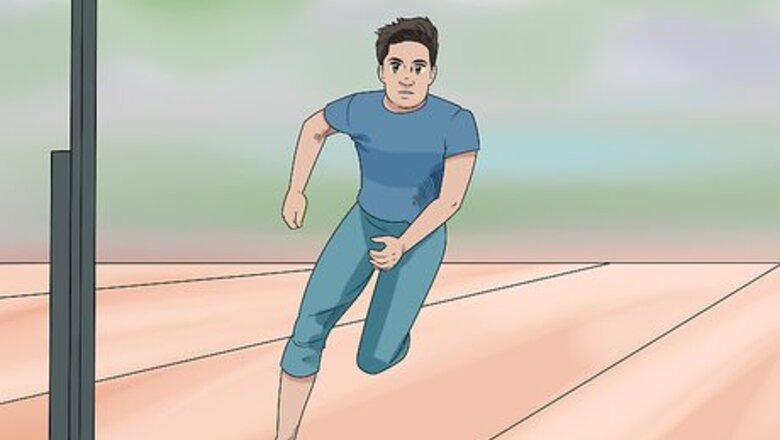
views
Perfecting the Run

Practice your running technique. When a jumping man runs towards the bar they are building the momentum necessary to jump over the bar. Therefore, you need to perfect the running technique before you attempt to jump over anything. Practice by running towards a gymnastics mat and behaving as if there was a bar in front of it. This is the same kind of mat that will be behind the bar when you’re ready jump over it.
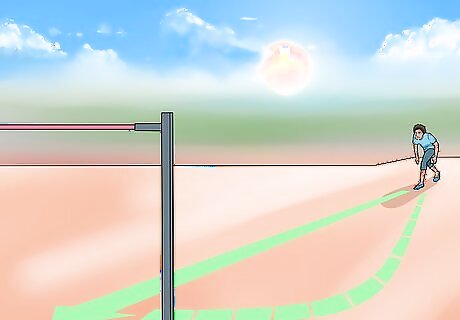
Prepare to run towards the mat. Most jumpers only take about 10 strides before they jump over the bar, so make sure you’re at least ten paces away from the mat to simulate this. If you’re a beginner step even further back about 5 to 6 strides to give yourself plenty of room to gain momentum. Don’t stand directly in front of the mat. You will be running in a “J” shape by turning towards the bar about ten strides into your run. Therefore, you need to be at least nine feet to the left or the right of the mat before you start running. If your right leg is dominant you should be to the right of the mat. If your left leg is dominant, go to the left of the mat. Women typically step 9 to 13 feet (2.7 to 4.0 m) to the left or right of the mat and begin their run 35 to 55 feet (10.7 to 16.8 m) back, while men typically step 12 to 16 feet (3.7 to 4.9 m) to the left or right of the mat and begin 50 to 70 feet (15.2 to 21.3 m) back.
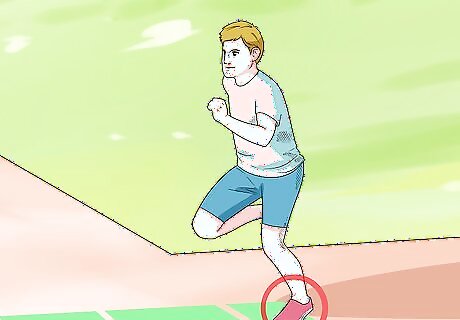
Begin running. Use your non-dominant foot to push off. Some athletes start low to the ground and will be in an upright position by stride three. Do what is most comfortable for you, but while practicing it may be easier to start standing up. Be sure to run in a “J” shape. The path you create with your run will look like a "J" because you run straight and then curve toward the bar at the end. Run straight toward the corner of the mat for about 5 strides to gain momentum. Begin to curve so you will eventually be parallel with the bar after about 3 strides. Do not accelerate or decelerate. Maintain a consistent speed so your momentum is not lost.
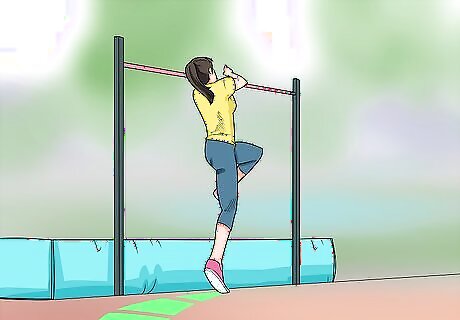
Jump towards the mat. This can also be called a “push off.” Push off into the air with your non-dominant foot. The non-dominant leg will automatically be extended as you jump and you'll drive up your opposite knee. Don’t land on the mat. Instead, land on your feet. At this point you are just practicing the running form. However, the mat will help to catch you if you accidentally fall.
Clearing the Bar using the Fosbury Flop
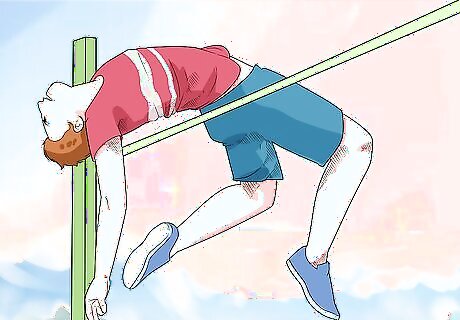
Practice the Fosbury Flop. This form was first used at the Olympics in Mexico City in 1968 by Dick Fosbury to win a gold medal. His technique, affectionately called the Fosbury Flop, requires leaping head first with your back to the bar. It is now the most common technique among professional jumpers.
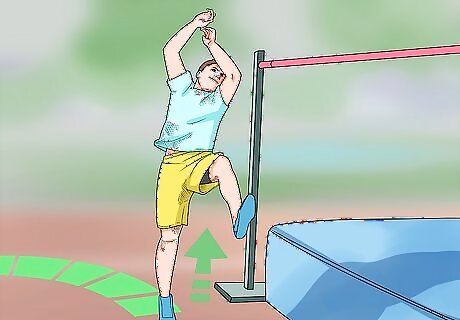
Prepare to launch yourself over the bar. When you’ve finished the “J” run and are next to the mat, rotate your back to the bar for the Fosbury Flop. As you drive your knee up and push off from your non-dominant leg, pivot your body to face the sky. This may feel unnatural the first few jumps, but keep practicing until it becomes second nature.
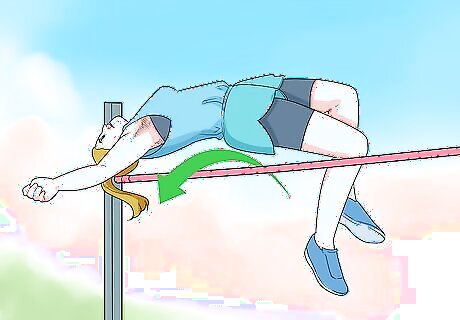
Clear the bar. Tilt your head and upper back toward the mat. Angle your head back and keep your chin un-tucked as you clear the bar to avoid injury. Arch your back up. As you arch and lift your hips over the bar, your head will fall back. After your hips have cleared the bar you will naturally tuck your head to your chest to help lift your feet over. Lift your feet up and over. Timing is critical here as there may only be a small amount of clearance for getting your legs over the bar. As your hips cross the bar and come down, give your legs a quick kick up and over to clear the bar. Try to keep your arms close to your body for a more solid center of gravity.
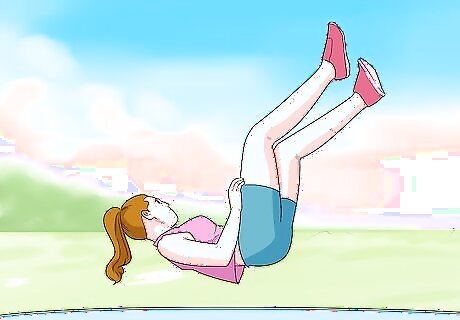
Land on the mat properly. Touch the mat with your upper back first. After clearing the bar you'll want to land on your upper back and shoulders to avoid injury. The rest of your body will follow and it may feel right to let the movement turn into a backward tumble. If so, relax and try to roll into the tumble. If you tumble, push the roll to either the left or right side of your upper back and put your body's weight over the respective shoulder (rather than directly over the head) so the pressure is distributed away from the neck. Keep your mouth closed. If you hold it open, you may bite your tongue.
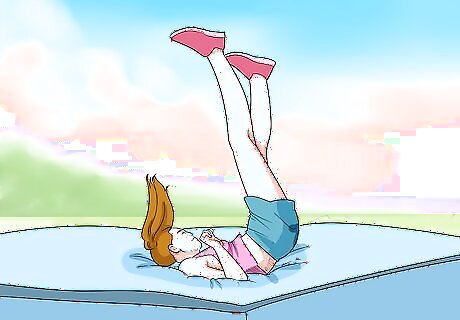
Resist the reflex to curl up. Keep your body open so that you don’t smash your knees against your face. Don't relax once your back touches the mat, and keep your legs a comfortable distance apart from each other as your knees will likely bend and come forward, even if you aren't rolling backward. If you hit the bar while jumping, it may be knocked off of its perch and into the air. If so, it may fall on you, on the mat, or be on an angle that could harm you if you land on it. If you hit the bar, cover your face with your arms while landing to prevent being injured by the bar.
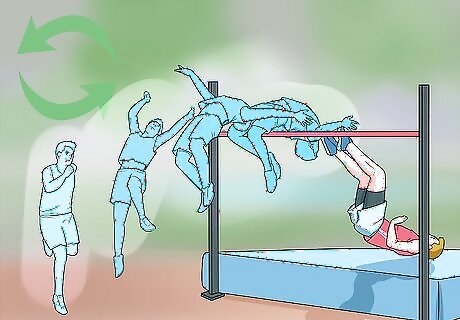
Improve your jump height and form. Practice jumping and landing until you’re completely comfortable with it. Nobody learns to high jump overnight, so don't get down on yourself if you find it challenging at first. Practice as much as you can and talk with other high jumpers or coaches to get tips. If a friend is watching they can give you pointers on how your form looks and help you perfect the landing on the mat. To push yourself, raise the bar in increments of 3 centimeters (1.2 in). Three centimeters may seem small, but you'll feel the difference the next time you try it. Some people find it helpful to record their progress in a journal. To do so, write down the height of the bar you’re jumping over as you practice. If you continue to raise the bar each week and record your highest jumps, you can track your improvement.
Clearing the Bar using Scissor Jumps
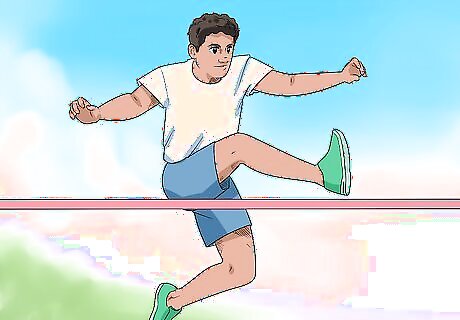
Clear the bar using scissor jumps. If the head-first flop looks too daring at this stage, you may choose to jump the bar a different way. A simple, less complicated jump called a “scissor jump” is done by following the same run path. Instead of flinging yourself backwards over the bar, you cross over the bar in a sitting position with your back straight and your legs extended in front of you. Make sure the bar is relatively close to the mat, especially if you’re a beginner. It’s important to master the technique before you attempt to jump over a high bar.
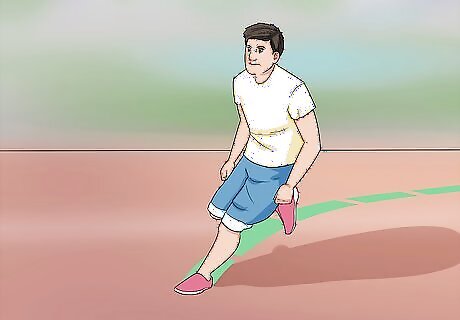
Run towards the bar at a steady speed to gain momentum. If you’ve practiced the “J” run enough, you should be able to confidently run towards the bar with the correct form. Don't cut corners during the "J" run to save time; it's important to run the full path to give yourself more momentum to jump.
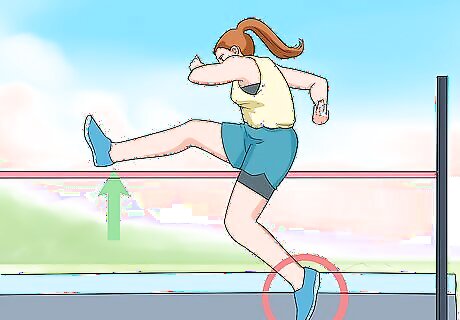
Push off from the ground. When you practiced running, you jumped by pushing off with your non-dominant leg and thrusting your dominant knee into the air. This time, push off with your non-dominant leg but swing your dominant foot into the air, keeping your leg straight. You should be bent at the waist as if you’re sitting on the floor, and your foot should never be higher than your hips. When you jump your body should be parallel to the bar. You will be jumping in a “sideways” motion that will carry you over the bar.
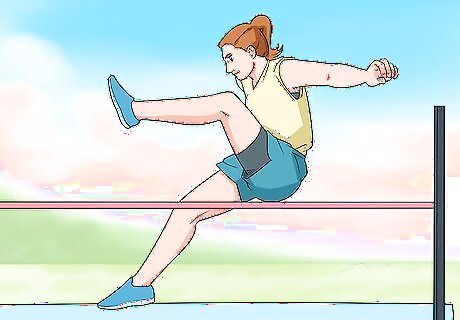
Complete the jump. Swing your non-dominant leg up towards your extended leg, keeping both legs straight. This will create a motion similar to scissors closing; thus, the name “Scissor Jump.” Keep your back straight and your legs extended in front of you. Your momentum will carry you over the bar and onto the mat.
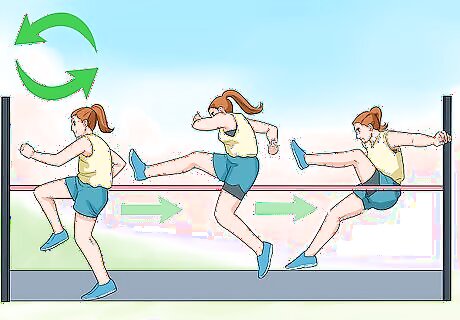
Improve your technique. Practice scissor jumping until you’re comfortable doing it. As you get better, increase the height of the bar slowly. Once you’ve reached your maximum height, it’s time to move on to a more advanced jumping form. If you want to jump higher, maximize your calves and hips movements as you jump up. So strengthen your calves. You have to work on the jump itself. An excellent way to do this is box jumps. For example, broad jumps, lunge jumps, squat jumps, and jumping will help you. You also have to strengthen your hips, and loosen your hip joints, especially your hip flexors, to jump higher and maximize that movement.



















Comments
0 comment